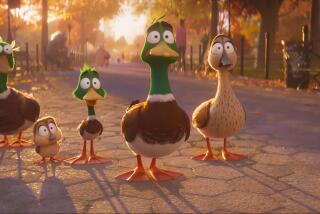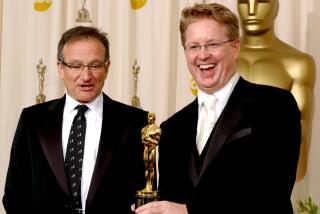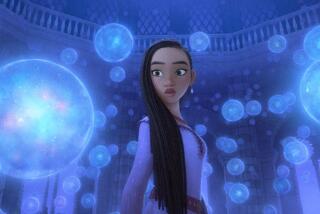MOVIE REVIEW : ANIMATION SINGS IN âSONG OF THE SOUTHâ
Many of the old Disney animators found their work on âSong of the Southâ (in re-release, citywide) more enjoyable than any other film, and itâs easy to understand why. Their adaptations of Brâer Rabbit, Brâer Fox and Brâer Bear from Joel Chandler Harrisâ âUncle Remusâ stories rank among the most vivid cartoon personalities the studio ever created.
When the wily Brâer Rabbit schemes to outwit the other two, he concentrates so intensely that every line in his body seems to be thinking. Similarly, Brâer Foxâs gestures emphasize his excitable, too-smart-for-his-own-good personality, and Brâer Bearâs ponderous motions demonstrate his monumental stupidity. While the vocal performances are uniformly excellent, these characters are so well animated, they can communicate thoughts and moods to the audience through pure pantomime.
âSong of the Southâ (1946) represented Walt Disneyâs first attempt to make a feature film that included extensive, dramatic live-action footage. The animation is reduced to illustrations of three stories told by Uncle Remus (James Baskett).
He tells the stories to entertain Johnny (Bobby Driscoll), a lonely rich boy whoâs been left at the plantation with his mother (Ruth Warrick) and grandmother (Lucille Watson). Johnny befriends Toby (Glen Leedy), a black child, and Ginny (Luana Patten), a poor white girl, but his real source of comfort and solace remains Uncle Remus. (Baskett received a special Oscar for his extraordinarily sympathetic portrayal.) From the Brâer Rabbit stories, Johnny learns how to cope with his adversaries--notably his priggish mother and Ginnyâs hooligan brothers.
The film is made up of about 70% live action and 30% animation, which New York Times critic Bosley Crowther remarked was âthe ratio of its mediocrity to its charmâ--a judgment that the intervening 40 years have only confirmed. The rather weak story line seems overly melodramatic, especially the scene in which Johnny is recalled from the brink of death by another of Uncle Remusâ stories.
Even more dated are the depictions of the black characters: The film is very much a â40s Hollywood vision of the Ole South. The field hands march to and from work in neatly pressed work clothes, singing elaborate choral arrangements of spirituals. Although Uncle Remus is permitted to exchange a conspiratorial wink with the shrewd old grandmother, he and Toby remain passive characters who patiently endure scoldings for things that arenât their fault.
The live action and animation are blended with a technical polish that astonished audiences in 1946, and remains impressive today. Uncle Remus appears to walk through a cartoon world, where he interacts casually and naturally with the animated characters. Cartoon birds and butterflies perch on his shoulders; when he casts a real fishing pole, the animated line lands in real water with an animated splash.
âSong of the Southâ is essentially a nostalgic valentine to a past that never existed, and within those limits, it offers a pleasant, family diversion for holiday afternoons when the children get restless.
More to Read
Only good movies
Get the Indie Focus newsletter, Mark Olsen's weekly guide to the world of cinema.
You may occasionally receive promotional content from the Los Angeles Times.










